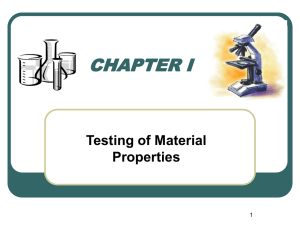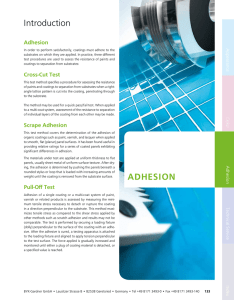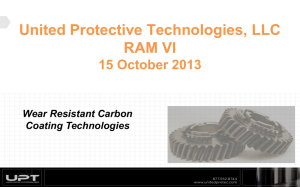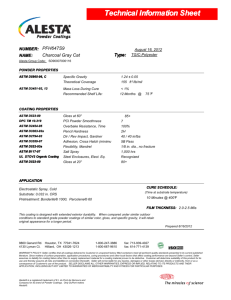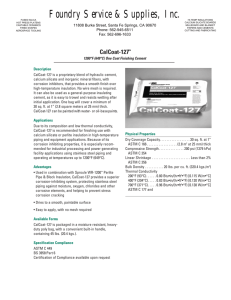AAC Guideline for Hardcoat Anodizing
advertisement
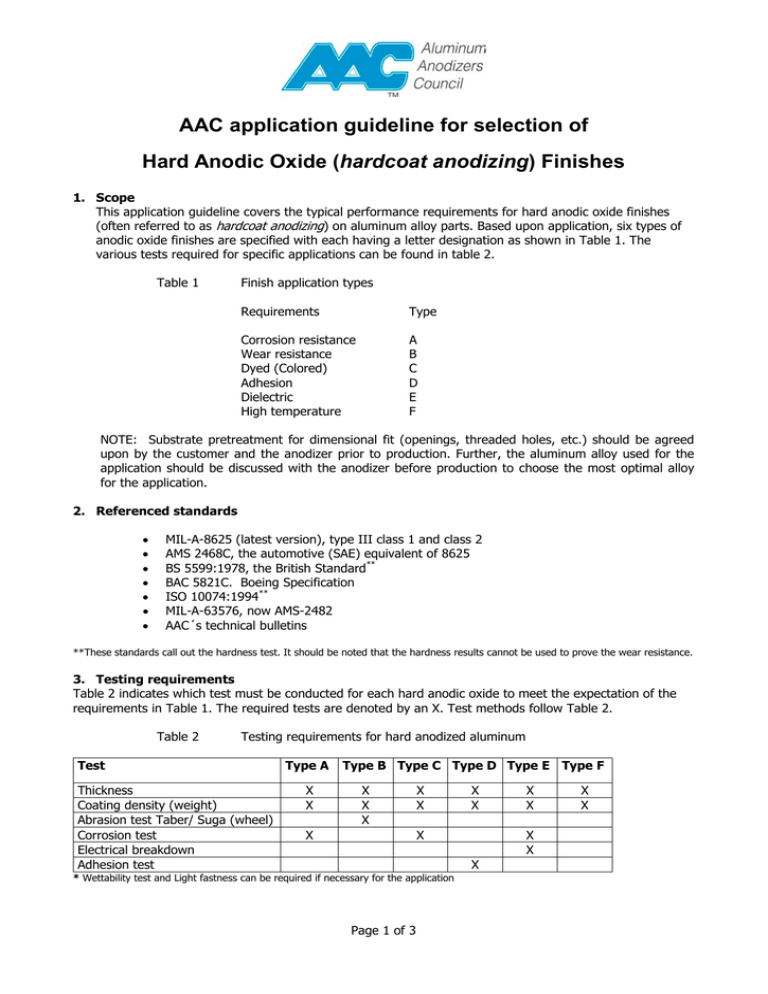
AAC application guideline for selection of Hard Anodic Oxide (hardcoat anodizing) Finishes 1. Scope This application guideline covers the typical performance requirements for hard anodic oxide finishes (often referred to as hardcoat anodizing) on aluminum alloy parts. Based upon application, six types of anodic oxide finishes are specified with each having a letter designation as shown in Table 1. The various tests required for specific applications can be found in table 2. Table 1 Finish application types Requirements Type Corrosion resistance Wear resistance Dyed (Colored) Adhesion Dielectric High temperature A B C D E F NOTE: Substrate pretreatment for dimensional fit (openings, threaded holes, etc.) should be agreed upon by the customer and the anodizer prior to production. Further, the aluminum alloy used for the application should be discussed with the anodizer before production to choose the most optimal alloy for the application. 2. Referenced standards • • • • • • • MIL-A-8625 (latest version), type III class 1 and class 2 AMS 2468C, the automotive (SAE) equivalent of 8625 BS 5599:1978, the British Standard** BAC 5821C. Boeing Specification ISO 10074:1994** MIL-A-63576, now AMS-2482 AAC´s technical bulletins **These standards call out the hardness test. It should be noted that the hardness results cannot be used to prove the wear resistance. 3. Testing requirements Table 2 indicates which test must be conducted for each hard anodic oxide to meet the expectation of the requirements in Table 1. The required tests are denoted by an X. Test methods follow Table 2. Table 2 Testing requirements for hard anodized aluminum Test Thickness Coating density (weight) Abrasion test Taber/ Suga (wheel) Corrosion test Electrical breakdown Adhesion test Type A X X Type B Type C Type D Type E Type F X X X X X X X X X * Wettability test and Light fastness can be required if necessary for the application Page 1 of 3 X X X X X X X 3.1. Thickness measurement The thickness of the anodic oxide should be measured by eddy current per ASTM B244 (EN ISO 2360:2004) and, if there is some question, by microsection according to ASTM B487-85(2007) or EN ISO 1463:2004. The thickness should be 2 mils (50 µm) unless otherwise specified (MIL-A-8625F, table IV). Normal coating thickness variation is considered to be + 20%, but may be different from this in accordance with the contract. 3.2. Coating density (weight) The coating weight is determined by the method described in ASTM B137-95 (2004). A test coupon is weighed before and after stripping off only the anodic coating using the stripping bath described in the standard. The difference in weight is the weight of coating per unit area. Unsealed Type III coatings shall have a minimum coating weight of 4320 milligrams per square foot for every 0.001 inch of oxide finish when tested. 3.3. Abrasion test Fed Std 141, Method 6192 describes the Taber Abraser test. The Abrasion Wheel test is EN ISO 8251. Some industries with special hard anodizing applications have specified special tests for wear resistance in accordance with the needs of the industry. 3.4. Corrosion test ASTM B117-07 and EN ISO 9227:2006 describe methods for salt spray chamber corrosion testing. This is the most common method used but the corrosion test should be application based, especially if the application is used in an alkaline environment. Evaluation of the corrosion test should be in accordance to end user specification. 3.5. Wettability test Two standards of interest are ISO 4920:1981 and ISO 3759:2007. 3.6 Light fastness In accordance with ASTM G23, ASTM D822 or EN 12373-8 as required and evaluated by ASTM D2244. 3.7 Electrical breakdown potential The electrical breakdown potential is measured in accordance with one of the two following standards: EN 12373-17:2001 or ISO 2376:2007 3.8 Adhesion test ASTM B571, “Adhesion of Metallic Coatings,” paragraph 4 , the “Burnishing Test,” describes a method to determine adhesion of various finishes on metal substrates. The coating is burnished with calibrated pencils and the site examined to determine if the substrate is exposed through burnishing. Substrate exposure after a prescribed number of strokes is considered failure. Paragraph 11 in the same standard is the “Peel Test.” The surface is taped and then cut and pulled at an angle of 90o to the surface of the piece with efforts to maintain the rate of pull. Following testing, the delaminated surfaces are evaluated to determine the point of failure. Inadequate adhesion is considered as failure in the oxide-substrate interface. Page 2 of 3 3.9 Hardness test The test method found in EN ISO 4516:2002 and ASTM E384-07 covers determination of the microindentation hardness of materials. This test method covers microindentation tests made with Knoop and Vickers indenters under test forces in the range from 9.8 10-3 to 9.8 N (1 to 1000 gf). The test method includes an analysis of the possible sources of errors that can occur during microindentation testing and how these factors affect the accuracy, repeatability, and reproducibility of test results. This is very important when measuring the hardness of the oxide layer formed by hard anodizing. 4. Initial source approval No shipment should be made by any supplier of anodic oxide finishes (from now on referred to as the supplier) to a customer until representative initial production samples have been approved by the customer as meeting the requirements of the applicable specification. 5. Inspection and rejection All shipments of materials or parts under contract or purchase order manufactured to specific demanded properties should be equivalent in every respect to the initial samples approved by the customer. Without prior notification and approval by the customer there should be no changes permitted in either formulation or manufacturing processes, which would produce products different from the initial production samples. Lack of notification by the supplier could constitute grounds for rejection of any shipment. While samples may be taken from incoming shipments and checked for conformance to this application performance guideline, the supplier should accept the responsibility for incoming shipments meeting this specification without dependence upon the customer’s inspection. It is, however, necessary that the customer inform the supplier of any alloy or manufacturing process change to components provided for finishing, as such changes would also produce products different from the initial production samples and constitute need for another initial source approval. 6. Recommendation These are recommendations; the end user is responsible for selection and performance of the recommended tests. Page 3 of 3
